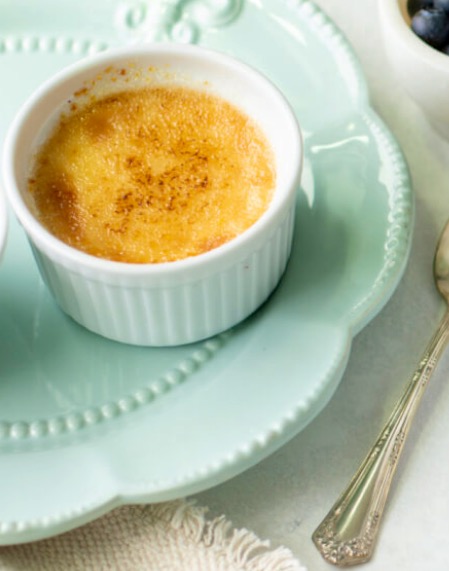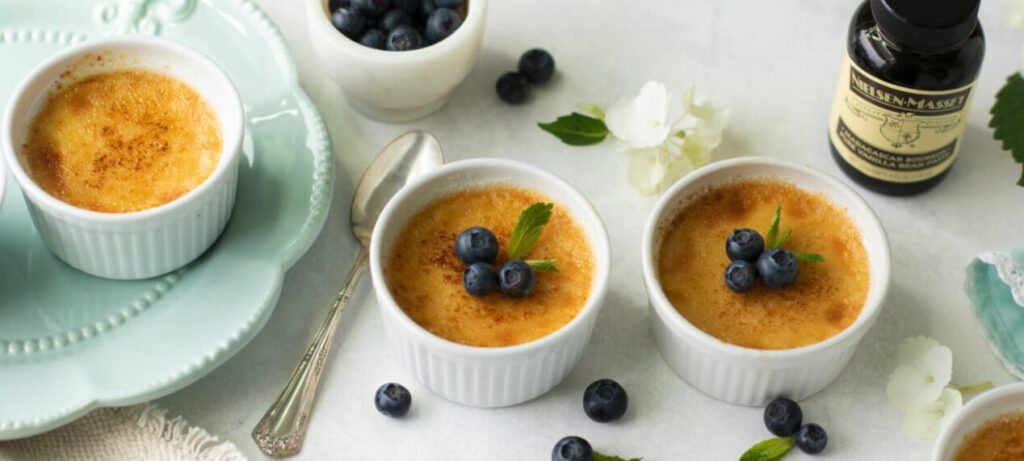Every year on 27 July, we celebrate National Crème Brûlée Day. This rich custard dessert topped with a contrasting layer of hard caramel, has a history that is both intriguing and somewhat contested. Its origins are often debated, with claims from France, England, and Spain each staking their own claim to this decadent dessert.
Before we get into this history of this dessert, let’s look at it’s definition. According to “The Oxford Companion to Sugar and Sweets”:
Crème Brûlée – crème brû·lée -brᵫ-ˈlā : a sweet egg-yolk custard made with cream. This cream, egg yolk, and sugar mixture is cooked, poured into individual ramekins, poached in a bain-marie, and then chilled. When the custard is firm, the top is covered with a layer of sugar that is browned by means of a salamander, broiler, or butane torch forming a hard, caramelized crust on the surface.

France
The term “crème brûlée” is French for “burnt cream,” and the dish is often attributed to French cuisine. The earliest known reference to crème brûlée appears in the 1691 cookbook “Le Cuisinier Royal et Bourgeois” by François Massialot, a chef at the Palace of Versailles. His recipe for “crème brûlée” involved caramelizing sugar on top of a custard base, a technique that has remained largely unchanged over the centuries.
England
In England, a similar dessert known as “burnt cream” or “Trinity cream” has been enjoyed since at least the 17th century. Trinity College, Cambridge, claims to have invented the dish, traditionally serving it with the college crest burnt into the sugar topping with a branding iron. They assert that their “Trinity Burnt Cream,” dating back to the 17th century, is the true predecessor. The recipe bears a striking resemblance to the French version, suggesting a shared or parallel development.
This recipe appeared in a number of English eighteenth-century cookbooks, notably John Nott’s “Cooks and Confectioners Dictionary” (1723), however the origin of the recipe in print appears to be French. “The British food writer Elizabeth David traced Nott’s recipe for “Burnt Cream” to François Massialot’s crème brûlèe recipe in Cuisinier royal et bourgeois (1691),” states Kyri W. Claflin in “The Oxford Companion to Sugar and Sweets.”
Custard-based desserts have been popular since the Middle Ages, but the specific creation of crème brûlée remains a subject of debate. While they can’t definitively prove they invented it, the dessert remains a staple on their menu to this day.
Claflin writes that unless a seventeenth-century precedent is found, “Massialot seems to have been first in English as well as in French” to publish a recipe for it. She also notes that in his recipe, it calls for milk, not cream, and the custard bakes in an oven and not a bain marie. She goes on to say that Massialot also forgets to tell the cook to add sugar in the cooking stage, but does mention it “in the custard later in the recipe. If the omission was a mistake, it was never corrected.”
Spain
Spain counters with its crema catalana, which dates back to the Middle Ages. Though culinary historians note that it differs from crème brûlée in preparation method. The Spanish version is not baked in a water bath, a key characteristic of the French dessert. This variation is flavored with lemon or orange zest and cinnamon, and it is usually made with milk instead of cream. The method of caramelizing sugar on top remains a common element, linking it to the other European versions of the dish.
Claflin states that Massialot also had a similar recipe called Crème à l’Angloise in his “Nouvelle Instructions pour les Confitures” (1740 edition) – however this one calls for sugar to be cooked with the egg yolks. Another version from Elizabeth Raffald’s cookbook, “The Experienced English Housekeeper” (1769) is similar to Massialot’s however her recipe adds beaten egg whites to the custard mixture.
“The apparent name change for the same dessert prompted the editors of ‘Petits Propos Culinaries’ to question whether French cooks got the idea to credit the English for the dish.” For years the name and the dessert came and went in various forms. Claflin states that although crème brûlée is “conspicuously absent from the major nineteenth- and early twentieth-century French cookbooks” it reappears, closely following Massialot’s version, in Eleanor L. Jenkinson’s “Ocklye Cookery Book” (1909).
The recipe starts appearing in other cookbooks including:
“Cordon Bleu Cookbooks” – Dione Lucas – (1947)
“Gourmet’s Menu Cookbook” – (1963)
“Flavor of France” – Samuel and Narcissa Chamberlain (2nd edition – 1969)
“Everyday French Cooking for the American Home” – Henri-Paul Pellaprat – (1978)
“Bistro Cooking” – Patricia Wells (1989).
When Wells published the recipe in her cookbook she said it “seems to be one of the world’s favorite desserts, at least in our time.” It still is Patricia!
Making Its Way Across the Atlantic
The dessert made its way across the Atlantic, with reports of Thomas Jefferson serving it at the White House during his presidency. However, it wasn’t until the late 20th century that crème brûlée truly captured the American palate.
Modern Era
Crème brûlée gained widespread popularity in the United States during the 1980s and 1990s, becoming a staple on dessert menus in upscale restaurants. In the 1980s, Sirio Maccioni’s Pastry Chef Dieter Schorner, put crème brûlée on the menu of New York’s upscale restaurant La Cirque, thereby catapulting the dessert to elite status.
In his memoir, “The Story of My Life and Le Cirque,” Maccioni writes that the “most important dessert of the Schorner period was crème brûlée.” He went on to take credit for reintroducing the dessert saying he made it “the most famous and by far the most popular dessert in restaurants from Paris to Peoria.” He states that he first tasted the Catalonia dessert – crema catalana -on a trip to Barcelona and that inspired him and Schorner to create “Crème Brûlée Le Cirque.”
This move sparked a culinary trend that spread rapidly across the United States and beyond, cementing crème brûlée’s place in the pantheon of beloved desserts.
Today, the Catalonian dessert is made the same was as crème brûlée.
Crème brûlée continues to be a favorite among diners worldwide, its popularity a testament to its timeless appeal. While its exact origins may remain a mystery, there’s no disputing the joy it brings to dessert lovers everywhere.The allure of the dessert lies in its textural contrast: the creamy, smooth custard juxtaposed with the crunchy, caramelized sugar topping.
Culinary Technique

The key to a perfect crème brûlée is in the careful preparation of the custard, typically made with heavy cream, egg yolks, sugar, and vanilla. Once the custard is baked and chilled, a thin layer of sugar is sprinkled on top and caramelized using a culinary torch or broiler, creating the signature brittle crust.
Cultural Impact
Crème brûlée has become a symbol of luxury and indulgence, often featured in movies, television shows, and literature. Its simplicity and elegance have made it a favorite for both home cooks and professional chefs alike.
The first thing a diner wants to do is to break through the hard carmel surface. Many judge a good crème brûlée by how loud the crack is once hit with the spoon. We don’t know if that is the sole way to judge a good crème brûlée, but it’s a good start!
In summary, while the exact origins of crème brûlée may be disputed among France, England, and Spain, its enduring appeal is universal. The combination of creamy custard and crunchy caramelized sugar continues to captivate dessert lovers around the world, securing its place as a classic in the pantheon of culinary delights.
Everyone has a recipe for a good crème brûlée. Some will add fruit like candied oranges or raspberries, while others will turn it from vanilla to chocolate, pumpkin, espresso, and more. For us, we love classic vanilla.
This recipe comes courtesy of our friends – and team sponsor – Nielsen-Massey Vanilla.
Vanilla Crème Brûlée
Yield: 6 4-ounce ramekins
| AMOUNT | INGREDIENT |
| 2 cups | Heavy Whipping Cream (we use Horizon) |
| ½ cup plus 3 Tablespoons | Granulated sugar, divided (we use Domino Golden Sugar) |
| 2 teaspoons | Nielsen-Massey Madagascar Bourbon Pure Vanilla Bean Paste |
| 3 each | Egg yolks (we use Vital Farms) |
| 1 each | Whole egg |
| 1/8 tea | Salt (we use Maldon) |
| 1/4 cup | Brown sugar, firmly packed (we use Domino) |

INSTRUCTIONS
Preheat oven to 325°F. Lightly butter six 4-ounce ramekins.
Combine whipping cream, 3 tablespoons granulated sugar and vanilla bean paste in a medium saucepan over low heat. Stirring constantly, cook until simmering and steam is rising, then remove from heat.
Whisk the egg yolks, egg, ¼ cup granulated sugar and salt in a large bowl. Temper the eggs with the hot cream by ladling about ½ cup of the hot cream into the egg mixture, whisking constantly while adding. Continue gradually adding the hot cream into the eggs, whisking the whole time, until about half of the cream has been incorporated. Slowly strain the egg and cream mix back into the pot of cream, whisking to combine. Pour evenly into the ramekins.
Place the ramekins in a 9×13-inch pan that has a depth of at least 2 inches. Fill the pan with enough hot water to reach one-third of the way up the side of the ramekins. Bake for 40-45 minutes or until set. Let stand until cool. Chill, covered, until ready to serve.
Before serving, combine brown sugar and remaining granulated sugar in a bowl and mix well. Sprinkle evenly over the top of each crème brûlée. Torch the top of each ramekin with a kitchen torch to caramelize the sugars or place the ramekins on a broiler pan and broil until the sugar caramelizes. If using the broiler to caramelize, rotate the ramekins so the sugar caramelizes evenly and watch closely for burning. Allow the sugar to harden slightly, then serve either plain or garnished with fruit.
Notes:
You can substitute Pure Vanilla Bean Paste in place of Madagascar Bourbon Pure Vanilla Bean Paste to achieve a different, but still delicious, flavor profile.
References:
Davidson, Alan. “The Oxford Companion to Food.” Oxford University Press, 2014.
Montagné, Prosper, and Jennifer Harvey Lang. “Larousse Gastronomique.”
Crown Publishing Group, 2001.
Glasse, Hannah. “The Art of Cookery Made Plain and Easy.” 1747.
Smith, Andrew F. “The Oxford Encyclopedia of Food and Drink in America.” Oxford University Press, 2013.
Goldstein, Darra (Edited). “The Oxford Companion to Sugar and Sweets.” Oxford University Press, 2015
LoveToKnow article on Creme Brulee History and Recipe
Gourmandise blog post “A Little History… Crème Brûlée”
Wikipedia
Cadbury Dessert Corner
pjponline